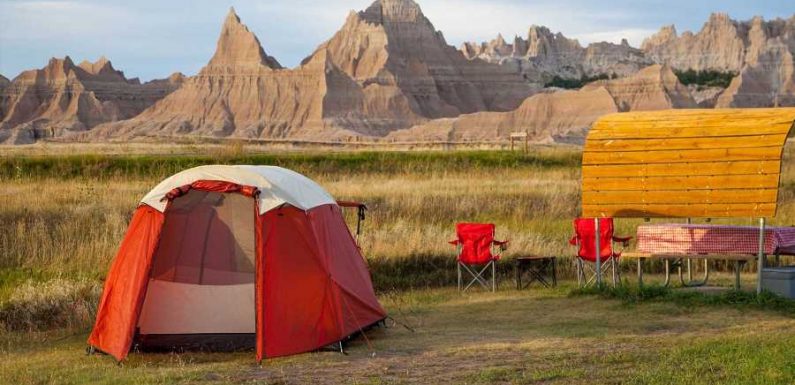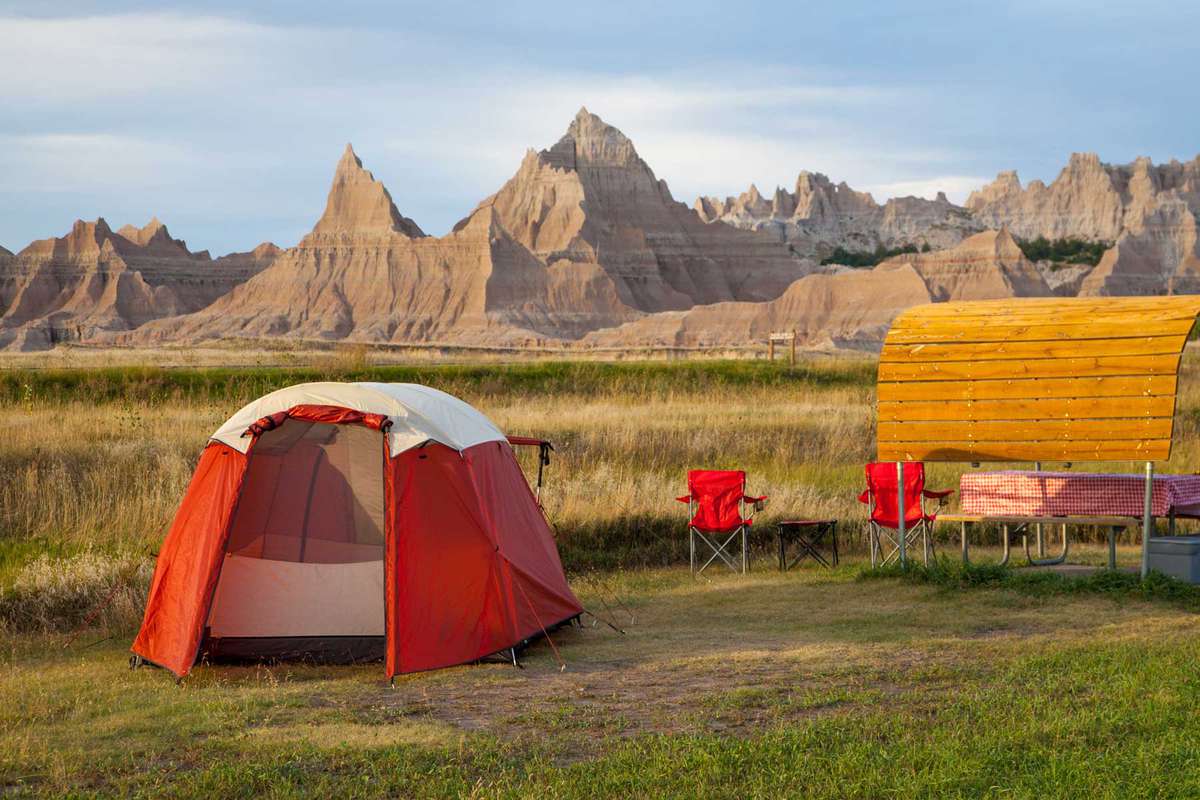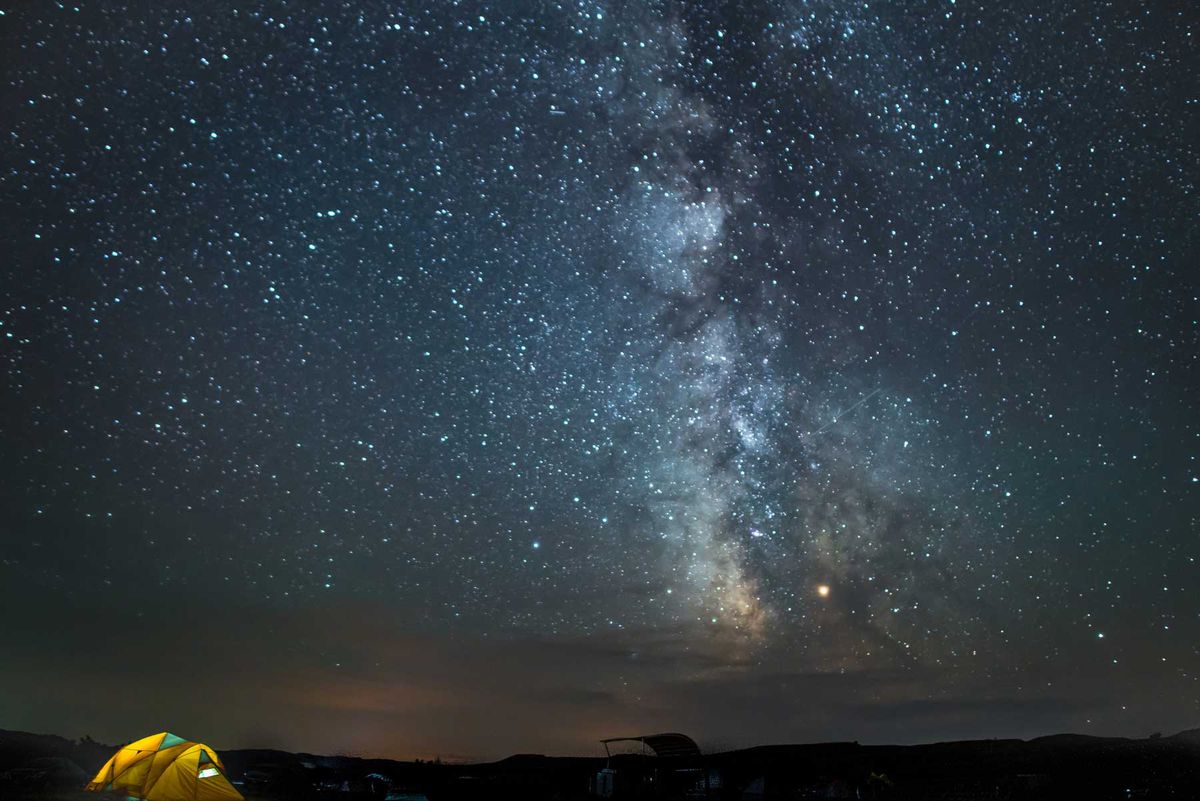
Badlands National Park may not see as many visitors as the Grand Canyon or Yosemite, but trust us, that's a good thing. The Badlands' striking landscapes are noticeably less crowded, making it easier to enjoy the beauty and solitude of the park's striped rock formations and dramatic canyons. Then, there's the wildlife — bison, bighorn sheep, and golden eagles, to name a few.
It's a corner of South Dakota that draws people from around the world, who make the journey to drive on Badlands Loop Road, hike on the Notch Trail, or spend time examining the myriad fossils that have been uncovered in the park.
The truth is, a day here just isn't enough, and since the park showcases an entirely different side at night — one that includes clear skies and a full view of the Milky Way — it only seems right to sleep under the stars. Luckily, there are plenty of options, from established campgrounds and RV hookups to rugged backcountry camping. To help you get started, here's everything you need to know before setting up camp in Badlands National Park.
Established and RV Camping in Badlands National Park
If you're looking for a camping experience with all the amenities (showers, water, groceries), head to Cedar Pass Campground, where you'll find 96 sites, including RV spots with electric hookups and cabin rentals at the nearby Cedar Pass Lodge. This year-round campground is your best bet for a full-service stay — there's an on-site restaurant, pay bathrooms and showers, drinkable water, and a gift shop that sells groceries and camping supplies.
Tent camping at Cedar Pass Campground costs $23 a night for two people and $4 a night for each additional person. Meanwhile, an RV site (with electric-only service) is $38 a night for two people and $4 a night for each additional individual. There are no water or sewer hookups, but those looking for a septic dump can find one nearby for $1. Reservations must be made in advance.
Established Yet Somewhat Rugged Camping in Badlands National Park
If setting up your tent near a giant RV isn't what you had in mind, you might be happier at Sage Creek Campground, a free, first-come, first-serve campground with 22 campsites. The campground is located off the unpaved Sage Creek Rim Road (which also makes for a beautiful drive), and campers should note that the road can close after rain or storms.
If you have an RV that's 18 feet or smaller, you're in luck, but those with bigger rigs will need to go elsewhere. All guests at Sage Creek Campground have access to covered picnic tables and pit toilets, but not water. Campers can either pack their own H2O, or drop by the Ben Reifel Visitor Center to fill up.
Backcountry Camping in Badlands National Park
Those looking for a true immersion in nature that's far from other campers have plenty of options. Backcountry camping is permitted anywhere within Badlands National Park — no permit needed — as long as the campsite isn't visible from any of the park's roads or trails and is at least a half-mile away. So, basically, you're free to set up camp almost anywhere within the park's 244,000 acres.
If the sheer number of options feels overwhelming, keep in mind that most backcountry campers tend to head to Deer Haven, a two-and-a-half-mile trail that travels along the base of the Badlands and opens up to various camp spots, including a grove of junipers and the top of a butte. Another popular destination is the Sage Creek Wilderness Area off Sage Creek Rim Road. The area is inhabited by bison, so simply hop on one of the game trails and walk until you find a spot that's a half-mile from the road and out of sight.
In the Badlands backcountry, you'll need to bring a backpacking stove (campfires are not permitted) and at least a gallon of water for every day you plan to be out. In addition, you'll have to pack out your trash and toilet paper.
A backcountry camping permit isn't required, but the park recommends that you contact a staff member at Ben Reifel Visitor Center or Pinnacles Entrance Station and let them know where you're headed. You can also pick up a topographic map. In general, the best and safest time to go backcountry camping in Badlands National Park is September and early October, after the summer thunderstorms have passed and the temperature begins to drop.
Badlands National Park Camping Regulations
Campfires are not permitted anywhere in Badlands National Park, due to fire danger, but you can bring your own camp stove or contained charcoal grill to use at the campgrounds and picnic areas. In the backcountry, backpacking stoves are allowed.
Potable water is available to campers within Cedar Pass Campground, but those who set up shop at Sage Creek Campground or in the backcountry will need to bring their own water (one gallon per person per day is recommended). Drinkable water is also available at the Ben Reifel Visitor Center.
Within the park, you'll find both paid and free camping, as well as campgrounds that require reservations and those that are first-come, first-serve. Those looking to set up camp at the more established Cedar Pass Campground or the Cedar Pass Lodge will want to reserve a spot well in advance by booking online or calling (605) 433-5460. Due to COVID-19 restrictions, there are a reduced number of sites. If you're open to sleeping at a spot without showers, running water, and flushable toilets, you can take advantage of Sage Creek Campground's first-come, first-serve style. Plus, camping here is free. However, since campsites are limited, you might want to show up early so you can be sure to nab a spot.
Tips for Camping at Badlands National Park
The weather in Badlands National Park can vary greatly. Summers are often hot and dry with occasional thunderstorms, while the park typically sees between 12 and 24 inches of snow during the winter months. In short, summers can be hot, with temperatures as high as 116° Fahrenheit, and winters can be cold. The best time to camp is in the latter half of summer and early fall, when the park is cool, but not cold. Keep in mind that June tends to be the wettest month. Lastly, no matter when you visit, make sure to come prepared with layers of clothing, hats, sunglasses, sunscreen, and plenty of water.
Source: Read Full Article











